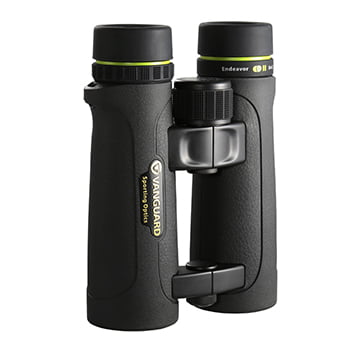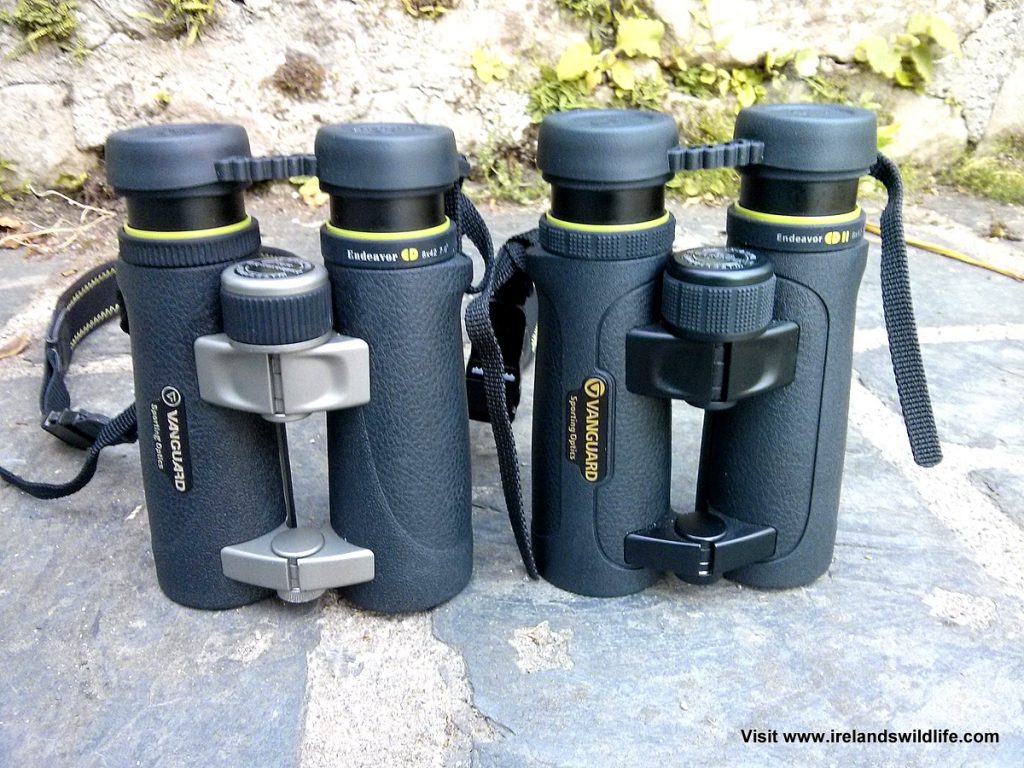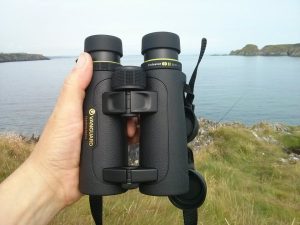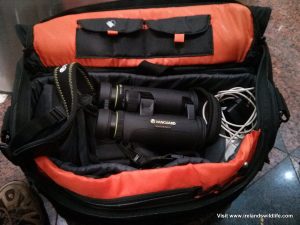 Pros: Superb build quality, excellent balance and high quality materials give a premium feel. excellent optics deliver a pin sharp, high contrast image right to the edge of the field. View appears almost flat… with very little field curvature. Good close focus performance. Practically no colour fringing (chromatic aberration).
Pros: Superb build quality, excellent balance and high quality materials give a premium feel. excellent optics deliver a pin sharp, high contrast image right to the edge of the field. View appears almost flat… with very little field curvature. Good close focus performance. Practically no colour fringing (chromatic aberration).
Cons: Focus mechanism a little aggressive at only 3/4 turn end-to-end. Field of view could be wider. Strap was too long for my preference even when adjusted to its shortest setting. Good rainguard but can be tricky to flick off quickly
Price: 8×42 model reviewed here was c. €575 (GB£449) at the date of writing, although you’re likely to find better deals online. The Endeavor EDII is also available in 8×32 and 10×42 configurations.
Value: Outstanding
Rating: Highly Recommended
The Endeavor EDII takes pride of place at the top of Vanguard’s binocular range. It builds on the foundation of the already impressive Endeavor ED, with premium Japanese optics that deliver high-end performance at a very affordable mid-range price point.
Vanguard continues to raise the bar, and proves yet again that these days you don’t have to pay silly money to own a pair of very high quality binoculars. The Endeavor EDII is an extremely capable binocular, and well worth a look if you’re shopping in this price bracket or even higher.
Check out the Vanguard EDII at the Vanguard UK Website.
Pick up a pair of Endeavor EDII via Amazon UK or Amazon US.
Vanguard Endeavor EDII: Full Review
When I heard earlier this year that Vanguard was working on a new top-end binocular to head up its sports optics range I was intrigued. I’d been impressed with the price / performance ratio of their Endeavor ED binocular, and was looking forward to seeing if they could maintain that focus on value while upping the ante in terms of quality and performance.
As it happened the launch of the new Endeavor EDII coincided with an extended trip to Australia and Southeast Asia (you can read about it in our #IWOnTour series). Vanguard Europe was good enough to send me a pair of the new 8×42 EDII ahead of their official launch date so that I could test them while away. I’ve been using them as my main binocular on the trip since the end of July, and have gotten to know them pretty well… so let’s see how they stack up.
First impressions

The Endeavor EDII is very similar to it’s sibling the Endeavor ED — the same basic open-bridge body design, with some subtle differences to the rubber armour, and black rather than silver hinges and focus knob (a welcome development that I think). The main differences though are on the inside, where Vanguard has used what it calls “outstanding Japanese ED glass”.
Even though the EDII is only marginally heavier (770g as opposed to 730g) You can feel the difference when you pick the binocular up. That’s not a criticism — it feels really solid — like a premium binocular should. The differences are subtle… but everything about the Endeavor EDII seems to lend the instrument a more polished feel than its already impressive sibling.
Balance, handling and build quality
 You’ll know, if you come here often, that I’m not a natural advocate of the dual hinge, open-bridge design. I prefer the contemporary single hinge design that leaves the lower barrel exposed for a true wrap-around grip. It just works better for me, and on one level I was hoping that Vanguard would change the design a little more radically and perhaps introduce a single hinge design with the EDII. As you can see from the images here, they didn’t. The EDII uses the same chassis as the earlier model — and I guess that’s understandable in terms of keeping development costs (and subsequently the price for the end user) low.
You’ll know, if you come here often, that I’m not a natural advocate of the dual hinge, open-bridge design. I prefer the contemporary single hinge design that leaves the lower barrel exposed for a true wrap-around grip. It just works better for me, and on one level I was hoping that Vanguard would change the design a little more radically and perhaps introduce a single hinge design with the EDII. As you can see from the images here, they didn’t. The EDII uses the same chassis as the earlier model — and I guess that’s understandable in terms of keeping development costs (and subsequently the price for the end user) low.
My personal preferences aside, the Endeavor EDII, like the Endeavor ED before it, is one of the most comfortable dual-hinge binoculars I’ve ever used.
The chassis of the Endeavor EDII is moulded out of magnesium alloy — extremely strong, lightweight material that is currently considered the optimum choice for high-end binocular construction. It’s the material you’ll find used in most of the top “Alpha” class binoculars several tiers up the pricing scale.
The body of the EDII It is covered with a very comfortable black rubber armour that provides excellent grip and helps to protect the optics within from the occasional knock and bump any instrument is going to get when used in the field. Make no mistake, while it may sport a mid-range price tag, there is nothing mid-range about the way this binocular feels.
It is an extremely comfortable binocular to use and carry in the field. Excellent balance and handling means that despite this being a premium-grade full-size binocular it’s not unduly taxing on your neck, arms and shoulders.
Mechanics
Not much to say here — everything works as it should. Hinges pivot with a satisfying amount of resistance, wheels turn smoothly and accurately with no play or “slop”, eye-cups twist in-and-out without issue. All good!
Focus
 The focus mechanism on the Endeavor EDII seems to be the same as the one used in the Endeavor ED… and the same criticism applies.
The focus mechanism on the Endeavor EDII seems to be the same as the one used in the Endeavor ED… and the same criticism applies.
While the focus is smooth, accurate, and works flawlessly on the unit I tested, it has the most aggressive focus ratio I’ve seen on any binocular. It takes just 3/4 of an anti-clockwise turn to go from a close focus of 2 metres out to infinity. Of course that means you can go from viewing a dragonfly at your feet to a soaring raptor in no time, but for me it’s just a little too aggressive to be comfortable. It’s a bit too easy to overshoot the point of focus, especially when you first use the binocular, or come back to it after using another model, and can make fine-focus a bit tricky.
You do get used to it, but I would prefer to see a slightly more pedestrian focus ratio.
Dioptre adjustment
The dioptre adjustment ring sits in the familiar location just under the right eyepiece. It is lockable, which means once you’ve set it you can’t accidentally change the setting — which is great. You simply click the ring up, adjust it, then snap it back into place to lock your setting in. Simple and very effective. There are also graduated markings on the binocular barrel that let you remember your setting for future reference — a small but welcome inclusion that manufacturers often miss.
Eye-cups and eye-relief
The Endeavor EDII has the familiar rubber-coated twist-up eye-cups you see on most roof prism binoculars today. They offer two intermediate stops between the fully down and fully up positions, which should give plenty of scope to set them for your viewing comfort. The maximum quoted eye-relief on the 8×42 model I tested is 19.5 mm, which is excellent, and means most people with glasses will have no problem using the binocular with their glasses on.
Weatherproofing
The Endeavor ED II is nitrogen purged and fully sealed, making it completely waterproof and impervious to the ingress of dust, sand and other foreign bodies. Purging with inert gas also ensures there’s no moisture present within the housing, which means no internal fogging, and no internal corrosion.
Optical Performance
Image sharpness and field of view
 The view through the Endeavor EDII is very impressive.
The view through the Endeavor EDII is very impressive.
It is bright, clear and sharp, with plenty of high-resolution detail right across the field of view. Sharpness at the edge of the field is exceptional, and there appears to be very little field curvature as you move out towards the edges. You generally expect some softening of the image as you move from the central “sweet spot” of a binocular out toward the periphery of the view. But with the Endeavor EDII I couldn’t detect any such softening — everything seems in focus. The view reminds me of some very expensive binoculars I’ve tested with “field-flattener” lenses.
Vanguard don’t mention field flatteners in the specification of the EDII… so they probably don’t use them, but they have done an amazing job of delivering a sharp edge-to-edge experience at this price point.
The field of view, while more than adequate at 7.2° (126m / 1000m), is not exceptional for a high end 8×42. A wide field of view helps when tracking fast moving wildlife, or scanning large areas, and I would have liked to see a little more improvement here. However, the bright, clear, sharp-to-the-edge image the Endeavor EDII delivers makes for a very pleasant all-round viewing experience. The field of view doesn’t feel constrained in any way, and that detailed edge-to-edge viewing experience goes a long way to make up for the fact that it’s not quite class leading in this regard.
Colour fidelity, contrast and chromatic aberration
The Endeavor EDII delivers a view with rich, vibrant colours and excellent contrast. You can easily pick out subtle variations in hue and texture. Colours are more or less neutral, with perhaps a slight warm bias to my eyes. Chromatic aberration (colour fringing) is pretty much non-existent. This is an area where Vanguard has improved things significantly with the EDII.
The Endeavor ED occasionally showed distracting chromatic aberration in tricky high-contrast lighting situations. With the EDII the high-grade Japanese glass seems to do its job well, and I struggled to find any at all, even when trying hard to induce it. I’ve never noticed any colour fringing during everyday use in the field.
Low light performance and coatings
 Vanguard doesn’t really give much detail about the coatings used in the Endeavor ED II other than to say all air-to-glass surfaces are fully multi-coated using Vanguard’s own proprietary suite of coatings. Given the similarities between the binoculars I think it’s a relatively safe assumption that the same suite of coatings used in the Endeavor ED has been used again for the EDII.
Vanguard doesn’t really give much detail about the coatings used in the Endeavor ED II other than to say all air-to-glass surfaces are fully multi-coated using Vanguard’s own proprietary suite of coatings. Given the similarities between the binoculars I think it’s a relatively safe assumption that the same suite of coatings used in the Endeavor ED has been used again for the EDII.
These include multiple layers of anti-reflective coatings on all glass surfaces, silver mirror coatings and phase correction coatings on the prisms to improve light transmission, colour fidelity and resolution.
I had wondered whether Vanguard might upgrade the prisms to a dielectric coating (the best currently available) for the EDII, and perhaps add a hydrophobic protective coating to the external lens surface. If they had though I’d expect the company to highlight these features in their marketing material, so in the absence of any information to the contrary I have to assume that the coatings used are similar to the earlier model.
Something is different here though, because the Endeavor EDII outperforms the ED in every way. Part of that can be attributed to the new, improved ED glass, but I’m not sure all of it can.
Whatever the nature of the coatings Vanguard use, they do a very good job of maximising light transmission and controlling flare and stray light in even in the most challenging of lighting conditions. I’ve used them in some of the harshest light conditions you’re ever likely to encounter while travelling around Australia over the last two months, and they’ve taken everything in their stride.
In terms of low light performance, while the Endeavor EDII isn’t the brightest binocular I’ve ever used, it does performs admirably well into twilight, and is as good as or better than most other binoculars I’ve tested in this price range. I never really found it wanting in this respect, and could easily pick out detail in shadow areas as the light faded.
Accessories
 The accessories that come with the Endeavor EDII are pretty much identical to those that ship with the Edeavor ED. There’s a high quality neoprene neck strap that doubles as a strap for the padded case thanks to the inclusion of quick-release buckles. There are the usual tethered objective lens caps, a high quality eyepiece rainguard and a branded microfibre cleaning cloth. No real surprises in there… but everything you’d expect to see is there and matches the binocular well in terms of quality.
The accessories that come with the Endeavor EDII are pretty much identical to those that ship with the Edeavor ED. There’s a high quality neoprene neck strap that doubles as a strap for the padded case thanks to the inclusion of quick-release buckles. There are the usual tethered objective lens caps, a high quality eyepiece rainguard and a branded microfibre cleaning cloth. No real surprises in there… but everything you’d expect to see is there and matches the binocular well in terms of quality.
For me the strap doesn’t adjust short enough (due to the quick release buckles) for the binocular to rest comfortably on my chest, and the rainguard can be a little cumbersome to flick off quickly if you have it in place and want to view something quickly. Apart from those minor foibles the accessories from Vanguard are excellent.
Warranty
Vanguard offers a “premium lifetime warranty” with its Endeavor line of optics. It covers defects in materials and workmanship for the original owner for life. As warranties go its a pretty good one… particularly in Europe, where lifetime warranties are a relatively new concept in the optics world.
Conclusions
Using the Endeavor EDII in the field has been a real pleasure. It’s a binocular that really grows on you. Good first impressions are backed up by solid performance as the binocular keeps delivering. The more I use these binoculars the more I like them.
I’ve been using the Endeavor EDII as my main binocular while travelling around Australia for the last two months, and I’ve never found its performance lacking. The Vanguard Endeavor EDII is an excellent all-round binocular that packs a whole lot of optical punch into a solid, ergonomic body at a very favourably price.
While it is an evolution of the Endeavor ED, rather than a revolution at the top of Vanguard’s range, the Endeavor EDII shows Vanguard’s commitment to refining its products over time, and delivers one of the most compelling price / performance ratios for a mid-range binocular on the market today. If you’re looking for high-end performance without the high-end price tag then this binocular is well worth a look.
Pick up a pair of Endeavor EDII via Amazon UK or Amazon US.
Acknowledgements
I’d like to thank Vanguard Europe for providing the Endeavor ED II 8×42 for review on Ireland’s Wildlife.
NB. Ireland’s Wildlife has no specific affiliation to any optics or gear manufacturer and all reviews on the site are completely independent and objective. If you’re an optics or gear manufacturer and would like to submit your product for review on the site please drop us a line using the contact form and we can take things from there.









5 comments
Matthew
Hi Calvin, Really impressed with your site and your reviews. I have just finished reading your Binocular Book on Amazon, a most excellent read. I have been using the original Vanguard Endeavor’s (8420) for 2 years, predominantly for bird watching and have always been pleased with the results, my only criticism would be their performance in low light conditions. I now feel ready for a change, on a recent trip to Titchfield Haven National Nature Reserve in Hampshire i field tested a pair of Hawke Frontier ED 8×43 (2015 Model) binoculars and felt they produced better results than my current Vanguard’s, especially on a dull day. I cannot be sure if the specification of the Hawke binoculars has changed since you reviewed them in 2013, however, do you think the latest Vanguard Endeavor’s II (8×42) should be considered before i go ahead and purchase the Hawks? Field testing the Vanguard Endeavour II’s is proving to be difficult due to no local stockists.
Thanks again for the time and effort you put in to producing such a wonderful site.
Matthew, Hampshire
Calvin Jones
Hi Matthew,
Thanks, I’m delighted you like the site and that you enjoyed the binocular ebook… when you have a moment I’d really appreciate it if you could leave a short review over on Amazon.co.uk for me.
As far as I know the current Hawke Frontier ED is the same model I tested back in 2013 here — it is an excellent binocular, and offers superb value for money and feature set and performce that rivals binoculars costing twice as much.
The Vanguard Endeavor EDII has a more premium feel to it in terms of its ergonomics and design, and delivers a superb edge-to-edge viewing experience. The field of view is narrower than that of the Hawke, but the edge-to-edge sharpness goes some way to negating that.
In terms of low light performance I found that both binoculars performed well but the Hawke does seem to be a little bit brighter, while the view through the Vanguards delivers better contrast and detail. Swings and roundabouts — as is often the case when comparing binoculars. In terms of image brightness it’s not an area the Endeavor EDII really improves much on from the original ED, so if you find those wanting, maybe the Hawkes are the way to go.
Which would I choose? I prefer the ergonomics of the Vanguard — which are still the most comfortable pair of dual hinge binoculars I’ve ever used. I really enjoyed using them as my main binocular during our extended trip last year. Overall they’d edge it for me over the Hawke’s I think — but it’s a close call, and the Hawkes are considerably cheaper (at least they are at list price), which could have a bearing on things.
Your call really — but I don’t think you’ll be disappointed with either binocular.
NB. If you’re planning on visiting Birdfair next month you should have the opportunity to try out both models — so it may be worth waiting and giving them a whirl.
Matthew
Calvin,
Many thanks for the comprehensive response to my question, very kind of you to take the time. I have written a short review of your ebook on Amazon.co.uk.
I contacted Hawk regarding the 2015 model of the Frontier ED’s, they replied as below:
“The 2015 version of the Frontier ED has only changed cosmetically as far as the Hawke logo and packaging. Hawke has recently undergone a big re-brand. With many of our products, it has only been the logo and packaging that has changed; the internal workings and technical specification have remained the same”.
I will be in London next month, this may provide an opportunity to test the Vanguard Endeavour II’s before making the final decision.
Thanks again for all your help and advice.
Best wishes
Matthew
paddyshaw
Hi Calvin – a brave decision to take a review bin as your main ones, but – having owned an 8x42EDII for three weeks now, can totally endorse your verdict. The strap just makes it to ‘short enough’ for me, and i’m a total convert to fast-focus now, what with working mainly on estuaries and big sky lines in East Anglia; it needs a morning of practice though, going from distant>close and back again. What do you make of the flat field?
This is something you’d expect from Swarovision, but in a £400 optic? Getting curious about how they’ve done this…..
Personally, the more i’ve used these, the more i like them! Enjoy the rest of your trip – apparently, it’s wet in Ireland…..
Paddy
Paddy Shaw
Hi Calvin – very good review! Having used the ED original 85×45 for three years, i agree with you that the EDII is a noticeable jump-up on what was already a good set of optics; solid, bright, distortion-free with great colour and contrast. Personally, i like a fast focus. Although i expect there are some that will find overshoot a problem at first; it’s just getting used to it…..FoV versus ‘distortion compromise’ is also a matter of debate, but unless you want to shell out £2000 on Zeiss SF, this may exist in many models, including some alphas.
I also agree that if you like the bins high on your chest, you may need to explore other lanyards. I’ve got mine shortened to the max, and can just about live with it, as the neck-padding area of the strap is exceptionally comfortable! I’ve made velcro straps 20mm wide to wrap round the plastic connectors, just to make the whole thing slightly more secure.
I’ve had my 8×42 EDIIs for a couple of weeks now, and have enjoyed every minute of them!
All the best for the rest of your trip!
Paddy